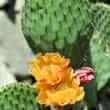Background
- Traditionally, nopal (also known as prickly pear) has both food and medicinal uses. Nopals are common in North American deserts and are generally sold fresh, canned, or dried for use in the preparation of nopalitos (a traditional Mexican dish made from nopal pads). They have a light, tart flavor. Nopals are commonly used in Mexican and New Mexican cuisine in dishes such as huevos con nopales (eggs with nopal) or tacos de nopales. The juice is used in jellies and candies. The fruit is also eaten fresh or used in pies, deserts, shakes, or spreads.
- Traditionally, nopal is medicinally used as an anti-inflammatory or a laxative. More recently, nopal has been used in exercise recovery and in reducing the symptoms of alcohol hangovers. Nopal is the most commonly used substance for lowering blood sugar among persons of Mexican descent.
- Nopal may offer benefits to individuals with an alcohol-induced hangover, diabetes, or hyperlipidemia (high cholesterol). However, additional study is needed.
References
- Ahmed MS, El Tanbouly ND, Islam WT, et al. Antiinflammatory flavonoids from Opuntia dillenii (Ker-Gawl) Haw. flowers growing in Egypt. Phytother Res 2005;19(9):807-809.
View Abstract - Aires V, Adote S, Hichami A, et al. Modulation of intracellular calcium concentrations and T cell activation by prickly pear polyphenols. Mol.Cell Biochem. 2004;260(1-2):103-110.
View Abstract - Cho JY, Park SC, Kim TW, et al. Radical scavenging and anti-inflammatory activity of extracts from Opuntia humifusa Raf. J Pharm Pharmacol 2006;58(1):113-119.
View Abstract - Ennouri M, Fetoui H, Bourret E, et al. Evaluation of some biological parameters of Opuntia ficus indica. 1. Influence of a seed oil supplemented diet on rats. Bioresour.Technol. 2006;97(12):1382-1386.
View Abstract - Ennouri M, Fetoui H, Bourret E, et al. Evaluation of some biological parameters of Opuntia ficus indica. 2. Influence of seed supplemented diet on rats. Bioresour.Technol. 2006;97(16):2136-2140.
View Abstract - Faldmo D, Stephan M, Boyd ST, et al. Dietary cactus reduces blood glucose levels in a Hispanic man. JAAPA. 2004;17(11):35-36.
View Abstract - Galati EM, Mondello MR, Lauriano ER, et al. Opuntia ficus indica (L.) Mill. fruit juice protects liver from carbon tetrachloride-induced injury. Phytother Res 2005;19(9):796-800.
View Abstract - Habibi Y, Heyraud A, Mahrouz M, et al. Structural features of pectic polysaccharides from the skin of Opuntia ficus-indica prickly pear fruits. Carbohydr.Res 4-28-2004;339(6):1119-1127.
View Abstract - Kim JH, Park SM, Ha HJ, et al. Opuntia ficus-indica attenuates neuronal injury in in vitro and in vivo models of cerebral ischemia. J Ethnopharmacol. 3-8-2006;104(1-2):257-262.
View Abstract - Li CY, Cheng XS, Cui MZ, et al. [Regulative effect of Opuntia powder on blood lipids in rats and its mechanism]. Zhongguo Zhong.Yao Za Zhi. 2005;30(9):694-696.
View Abstract - Pittler MH, Verster JC, Ernst E. Interventions for preventing or treating alcohol hangover: systematic review of randomised controlled trials. BMJ 12-24-2005;331(7531):1515-1518.
View Abstract - Qiu YK, Dou DQ, Pei YP, et al. [Study on chemical constituents from Opuntia dillenii]. Zhongguo Zhong.Yao Za Zhi. 2005;30(23):1824-1826.
View Abstract - Saleem R, Ahmad M, Azmat A, et al. Hypotensive activity, toxicology and histopathology of opuntioside-I and methanolic extract of Opuntia dillenii. Biol Pharm Bull 2005;28(10):1844-1851.
View Abstract - Tesoriere L, Butera D, Pintaudi AM, et al. Supplementation with cactus pear (Opuntia ficus-indica) fruit decreases oxidative stress in healthy humans: a comparative study with vitamin C. Am.J.Clin.Nutr. 2004;80(2):391-395.
View Abstract - Yoon HJ, Won CH, Moon SE. Allergic contact dermatitis due to Opuntia ficus-indica var. saboten. Contact Dermatitis 2004;51(5-6):311-312.
View Abstract







